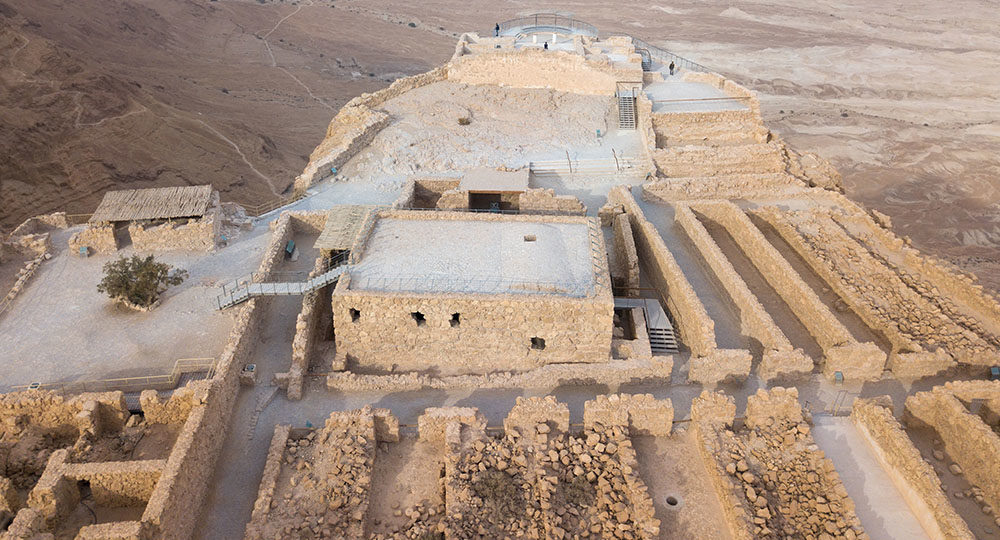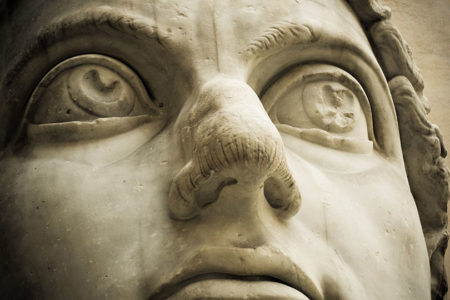Roman Madness at Masada
On Nisan 14 in the year 73 A.D., Jerusalem was quiet. Normally the city would have been full of Jewish pilgrims waiting in line for the Temple priests to sacrifice their Passover lambs. But on this day there were no pilgrims. There were no sacrifices. The priests were all dead, the people dispersed, the Temple burned to the ground. Almost three years earlier, four Roman legions, under the command of Titus, had devastated the city. It was all but abandoned now, desolate and silent.
Thirty-five miles southeast of Jerusalem, however, things were not so quiet. The new procurator of Judea, Flavius Silva, and more than 9,000 Roman troops were battling 967 Jewish men, women, and children. The melee would have gone fairly quickly had it not been for one element in favor of the Jews—Masada.
Masada the Fortress
Masada is a rugged mountain located near the southwestern shore of the Dead Sea. A natural fortress, Masada rises to a height of 1,300 feet on the east and 330 feet on the west. Shaped like a massive boat, it is sharply narrow on the north end, widens in the middle, then narrows again in the south. Its flat peak is roughly 1,950 feet from promontory to promontory and 650 feet across the center. Access to the top of the mountain is difficult.
Herod the Great had turned Masada into a place of refuge. True to his paranoia, Herod wanted a place to which he could flee if he was deposed of his power. At the same time, he wanted a winter resort in the warm climate of the Dead Sea. So, between 37 and 31 B.C., a citadel for Herod and his family was constructed on Masada’s summit. For protection, a 4,250-foot-long casement wall was built around the peak’s perimeter. This was a double wall containing lookout towers and small apartments. For luxury, the fort was complete with all the amenities—palaces, beautiful mosaics, public baths, a swimming pool, and an ingenious water-collection system. With the ability to grow and store crops, as well as to hold 1,400,000 cubic feet of water in 12 cisterns, Masada was well-equipped for people to withstand a long siege.
Realizing the strategic value of the stronghold, the Romans confiscated Masada after Herod’s death and kept it until 66 A.D., when the first Jewish revolt was taking shape. At that time, a band of zealots stealthily wrested control of the mountain from the Roman garrison stationed there. A zealot named Eleazar ben Yair eventually took refuge at Masada and became its leader. After Jerusalem fell in 70 A.D., a few survivors of the ordeal fled to Masada, bringing its population to almost a thousand. For the next few years the zealots living there conducted raids on both Roman and Jewish settlements. Meanwhile, the Romans concentrated on destroying remaining Jewish fortifications. Finally, it was Masada’s turn.
In 72 A.D., Flavius Silva mobilized Fretensis 10—the Roman legion encamped in southern Jerusalem—along with thousands of auxiliaries, and marched them through the Judean desert to the foot of Masada. Accompanying the Roman soldiers were thousand of Jewish prisoners brought to the encampment to serve as slave labor. The total entourage may have reached 15,000.
The sight of such a formidable fortification as Masada must have initially disheartened even the most roughened legionnaire. Sizing up the situation, Silva put the troops to work. To prevent the zealots from escaping, a six-foot-thick siege wall was erected around the entire mountain. Eight base camps were established. Silva’s camp was on the northwest side of Masada. From there he could oversee the construction of his most important siege work—the ramp. Using tons of dirt, large stones, and thousands of Jewish slaves, a massive assault ramp was built on the west side of the fortress. When completed, the ramp was close to 300 feet high, 600 feet long, and 600 feet wide at the base. The Jewish defenders attempted to thwart the ramp’s construction by rolling huge stones, each weighing close to 100 pounds, down the side of the mountain. Although this defensive action certainly caused serious injury, it was not enough to stop the concentrated efforts of the legion.
After months of labor, the assault embankment was finished. The Romans’ next step was to construct a large, ironclad siege tower at the top of the ramp, from which they rained arrows down upon the zealots. Hundreds of grapefruit-size ballistic stones were also catapulted toward the Jewish patriots. All the while, a Roman battering ram crashed against the stone casement wall. When a breach in the wall was finally made, the Romans saw that the zealots had built another wall behind it. This too was a double wall, made of wood with dirt as filler. The battering ram proved unsuccessful against this wall, for the dirt helped to cushion the blows. Consequently, Silva commanded that wall be set on fire. When a north wind blew the fire back into the Roman soldiers, the Jewish defenders believed God was coming to their aid. However, the wind shifted to the south and tossed the flames onto the wooden wall, setting it ablaze. As the wall burned, the Romans decided to retire to their camps and wait until the following day for the coup de grace. Nisan 14, 73 A.D., came to an end with the Romans dreaming of conquest and glory.
Masada the threat
Of all the occupied territories in the Roman empire, perhaps none was as troublesome as Judea. Since taking over this little stretch of land in 63 B.C., Rome had to deal with seemingly endless skirmishes and insurrections led by self-styled deliverers and would-be kings. The New Testament speaks of Theudas and his four hundred men; Judas of Galilee, co-founder of the zealots (Josephus, Antiquities 18.1.1); and an Egyptian leader of four thousand (Acts 5:36–37; 21:38). Josephus referred to numerous others. Following Masada, there were Jewish revolts in Cyrene, Egypt, and Cyprus (115–117 A.D.). Finally, a second Jewish War occurred in Judea under the mantle of Simeon Bar-Kokhba (132–135 A.D.).
These rebellions were not just political. Most had messianic elements to them as well. Masada was just one example.
The Romans crushed all of these uprisings. They had no choice. First, from a political perspective, they obviously could not allow any rebellion to go unpunished. Second, they were deeply concerned that fomenting Jewish insurrections would infect surrounding territories, if not the entire empire (Josephus, Wars 3.1.2). Third, and most significant, they were afraid of the promised Messiah.
Ancient sources indicate that the Roman empire was not only aware of the Jewish prophecies predicting a Messiah but, in particular, the prophecies in the Book of Daniel concerning the overthrow of the fourth kingdom and the fourth beast—Rome (Dan. 2:40; 7:7).
Josephus implied the destruction of Rome in his discussion of Daniel (Antiquities, 10.10.4; 10.11.7). He also claimed that the first Jewish War was primarily caused by a misinterpretation of a Jewish messianic prophecy. “But now, what did most elevate them in undertaking this war, was an ambiguous oracle that was also found in their sacred writings, how, ‘about that time, one from their own country should become governor of the habitable earth.’ The Jews took this prediction to belong to themselves in particular and many of the wise men were thereby deceived in their determination” (Wars, 6.5.4).
The Roman historian Tacitus (ca. 55–117 A.D.) spoke of this same prophecy. “The majority firmly believed that their ancient priestly writings contained the prophecy that this was the very time when the East should grow strong and that men starting from Judea should possess the world” (Histories, 5.13).
Suetonius (ca. 69–140 A.D.), another Roman historian, wrote, “There had spread over all the Orient an old and established belief, that it was fated at that time for men coming from Judaea to rule the world” (Lives of the Caesars, The Deified Vespasian, 4.5).
Rome took seriously these prophetic messianic threats. Not satisfied with the slaughter and subjugation of the Jewish people, Roman emperors went even further to make sure the Son of David would not appear. “Vespasian after the conquest of Jerusalem gave orders that all that belonged to the lineage of David should be sought out, in order that none of the royal race might be left among the Jews”; “Domitian [81–96 A.D.] had commanded that the descendants of David should be slain.…For Domitian feared the coming of Christ as Herod also had feared it”; “Certain of these heretics brought accusation against Symeon, the son of Clopas, on the ground that he was a descendant of David and a Christian; and thus he suffered Martyrdom, at the age of one hundred and twenty years, while Trajan was emperor [98–117 A.D.]” (Eusebius of Caesarea [ca. 260–340 A.D.], Ecclesiastical History, 3.12; 3.19; 3.20.2; 3.32.3).
Masada the hope
From a spiritual perspective, we know that ancient Rome, the crown jewel of Satan’s rebellious world system, was hungry for control, domination, and worship. Thus, Rome’s need to suppress and eliminate any hope of a coming Messiah was based on the fear of losing that for which it hungered. The same will be true in the future. The Scriptures tell of a revived Roman empire ruled by a deified emperor that is yet to come. In an effort to wipe out any hope of deliverance, this satanically controlled Antichrist will seek to destroy all that is of God, including Christians and the Jewish people (Rev. 13). Ultimately, he will turn his armies against the true Messiah when He is revealed in the heavens (Rev. 19:19). But Rome failed to extinguish the messianic hope at the Messiah’s first coming, and it will fail at His Second Coming as well.
On the morning of Nisan 15, 73 A.D., the first day of the Feast of Unleavened Bread, Flavius Silva and his troops adorned their armor, strapped on their swords, and eagerly marched to the crest of Masada. Anticipating the release of pent-up frustrations, they charged through the burned-out wall and braced for the rush of leather and steel that was sure to come.
Instead, an eerie silence greeted them. Buildings were on fire. Smoke wafted through the early morning light. But no enemy confronted them. At a loss, the soldiers gave a shout, as if to beckon their opponents out of hiding. Two women and five children appeared. From them, Silva and his men learned the truth. During the night, Eleazar ben Yair had made an impassioned speech to his beleaguered compatriots. “Let us die before we become slaves under our enemies,” he had said, “and let us go out of the world, together with our children and our wives, in a state of freedom.” Stirred to their souls, the assembly agreed to a mass suicide pact. Fathers tearfully dispatched their wives and children. The rest were killed by ten men chosen by lot. Of those ten, one was chosen by lot to kill the other nine. Upon setting fire to the various complexes, the remaining zealot took his own life. The surviving women and children had hidden themselves in the underground caverns to escape the night’s terror.
Silva and his men were disappointed at not being able to vanquish their enemies with their own hands. Yet they could not help but admire the courage displayed by the 960 Jewish fighters who chose death and freedom over life and slavery to imperial Rome.
The word Masada is said to mean stronghold. Today, this stronghold is once again in Jewish hands. When the recruits of the Israel Armored Corps take their oath of allegiance, they do so on the summit of Masada. “Masada shall not fall again!” they cry. To them, this jagged rock is the symbol of hope and courage.
There is a far greater stronghold, however. There is a greater fortress, a greater hope. It is found in the true deliverer. He too gave up His life at Passover, although His sacrifice was to obtain an eternal freedom. Despite all the attacks of the enemy, those who place their trust in Him shall not be moved. They have sought refuge in the rock “cut out without hands.” It will grow into a great mountain, filling the whole earth (Dan. 2:34–35). That rock is Jesus, our Messiah, our Masada.








1. Masada (in Hebrew) means Fortress (not “stronghold” as you have put it).
2. The belief in the Messiah (and the advent of a Messiah) was a very destructive belief (if not the most) in the Jewish faith. And probably- in any faith.
3. “Masada shall not fall again”. Right. But it is not only the arm soldiers who chant it. It is all of the Jewish people (citizens, women, youngsters, old) who came from the ashes of the holocaust, and now they have a country; the same country that was demolished by the Romans (under Adrian). We can only hope that this will be true.